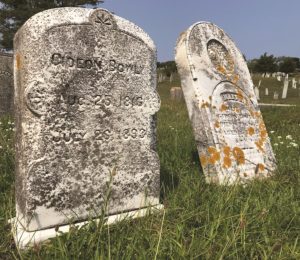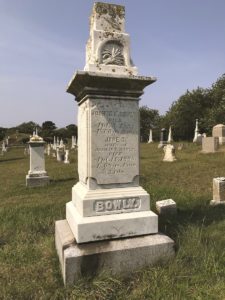During Provincetown’s fishing and whaling heyday, the Bowly brothers — Joshua Elsbury (1813-1883) and Gideon (1816-1893) — were among the town’s most prominent owners and outfitters of vessels. In 1849, J.E. & G. Bowly constructed a wharf and chandlery at the foot of Court Street, later extending the wharf and renaming it Steamboat Wharf to accommodate passenger steamships in which the Bowlys also had a financial stake.
In March 1859, as the Bowlys’ 108-ton whaling schooner Rienzi was outfitting for an Atlantic whaling voyage, few could have imagined the prize it would find at sea a year later. Capt. Liberty Gilbert Milliken had taken command for the voyage. A New Hampshire native, he married Hannah Nickerson Oakman of Provincetown, the daughter of Joseph Oakman and Provincetown-born Mary Nickerson. Hannah’s sister Mary Wheeler Oakman was married to Gideon Bowly. Beginning in 1850, five children were born in Provincetown to Liberty and Hannah, the last in 1859 while Liberty was at sea.

On Sunday, April 1, 1860, the Rienzi was cruising the waters of the West Indies near Puerto Rico. Ship keeper Freeman Atkins Smith noted in Rienzi’s journal (now in the collection of the Mystic Seaport Museum) that the “day commenced with fine and pleasant weather.” At 11 a.m., crewmembers saw a sail ahead and by 4 the “sail that was in our sight is off our weather beam. … Her maneuvering was rather singular. She layed all aback with her spanker boom hauled over to the weather side. She had all sail set.” At 4:30 the Rienzi “hauled up for her. At 5 p.m. Mr. [Francis] Godfrey went on board of her.”
Notified that the vessel was abandoned, Capt. Milliken launched a whaleboat and joined Godfrey onboard. Painted black and with a heavy copper hull, the brig bore no name or flag. Amply stocked with rice, beans, fish, and jerked beef, as well as water, wine, and rum, she appeared to have been fitted out recently. Well-appointed staterooms finished in mahogany and boxwood showed evidence of a violent confrontation. Walls were scarred with ax and crowbar marks and bloodstains darkened the floors. The ship’s hold bore shameful witness to the vessel’s purpose: lumber for a slave deck, shackles, ring-bolts fastened to the ceiling, boxes of wooden spoons and wide-headed tacks — to be cast across the floor to prevent escape — indicated that the brig was a slaver for the transatlantic trade.
After sailing alongside the brig for days, Smith noted in the log for Thursday, April 12 that “we have concluded to send the brig home under the command of Capt. Josiah Hill, Jr. [the Rienzi’s second mate] She is to leave here this afternoon.”

On the evening of May 10, 1860, the mystery brig, described by the Barnstable Patriot as a “noble looking craft” and “full of provisions,” rounded Long Point and arrived at Bowly’s Wharf. In time, particulars about the brig began to emerge. A receipt found onboard identified her as the Spanish-built Don Juan from Havana. There had been no account of her after March 11, and her crew, it was reported, had mutinied and murdered the captain for the $30,000 he carried to purchase slaves in Africa. Crewmembers were later found in Havana and Puerto Rico. Condemned and seized by the U.S. government as a slaver, the brig was sold at auction to Charles W. Adams of Boston, who renamed her Charles W. Jordan and outfitted her for legitimate work. Most of the cargo, it was reported, was sold to Messrs. J.E. & G. Bowly for $1,800.
On June 14, 1860, after a 15-month voyage, the Rienzi returned home. Smith’s entry in the ship’s log reads: “We passed Long Point Light and so we came to an anchor in Provincetown Harbor. Nothing more worthy of note. So ends this day.”
The Rienzi returned without Capt. Milliken, who had died at sea of yellow fever, surrounded by his crew. In the log for June 5, Smith had written that “at 12½ o’clock, Capt. Milliken expired. He is no more. He did not seem any distressed at all.” The next day, Rienzi crewmembers were joined onboard by crews from other Provincetown vessels. Smith read passages of Scripture, after which the body of “our beloved Captain” was committed to the ocean’s depths.

As for the Rienzi, she continued whaling during the Civil War years until July 8, 1863, when Capt. Peter Avery was homeward bound with a cargo of whale oil. Sailing 75 miles southeast of Gay Head, Avery spotted a vessel later identified as the Confederate privateer Florida cruising toward the brig W.B. Nash, bound from New York. Witnessing the brig being set on fire and the Florida steering toward them, the Rienzi crew abandoned ship. Taking to the whaleboats and pulling away, they watched helplessly as their vessel, too, was burned. Rescued by a passing vessel, the crew was landed safely at Woods Hole. Capt. Avery continued at sea until April 9, 1873, when the three-masted schooner under his command, William H. Andrews, sailing from Philadelphia to Portland, Maine, foundered off Barnegat, N.J. with the loss of all hands.
In Provincetown, the Rienzi and the “mystery brig” remained in the town’s collective memory long after the events of 1860. In 1910, when Freeman A. Smith died at the age of 78, his obituary noted not only his Civil War service but that he was one of the last survivors of the whaler that had found the “tenantless slaver brig sailing erratically in the mid-Atlantic.” In 1917, the Provincetown Advocate, reporting the illness of Cushing Emery (1841-1918), made mention of Emery and Jesse Ghen being the “only surviving members of the crew that brought to this port the slaver brig found abandoned at sea many years ago.” Ghen, who had celebrated his 19th birthday during the voyage, died in Melrose in 1919, ending living memory of the Rienzi.



